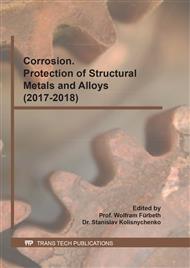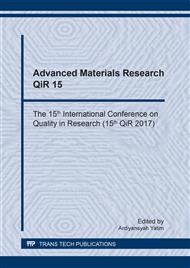[1]
M. A. Al-Ghazal, S. M. Al-Driweesh, A.-Z. Mustafa R, and F. A. Al-Ghurairi, Limited Entry, Multiple Injection Matrix Acidizing Technology Boosts Well Production in the World's Fourth Largest Gas Reserves,, Saudi Aramco J. Technol., vol. Spring, p.2–9, (2014).
DOI: 10.2118/167306-ms
Google Scholar
[2]
L. T. Popoola, A. S. Grema, G. K. Latinwo, and B. Gutti, Corrosion Problems During Oil and Gas Production and its Mitigation,, Int. J. Ind. Chem., vol. 4, no. 35, (2013).
DOI: 10.1186/2228-5547-4-35
Google Scholar
[3]
A. Singh and M. A. Quraishi, Acidizing Corrosion Inhibitors : A Review,, Journal. Mater. Environ. Sci., vol. 6, no. 1, p.224–235, (2015).
Google Scholar
[4]
A. Rustandi, J. W. Soedarsono, and B. Suharno, The Use of Mixture of Piper Betle and Green Tea as a Green Corrosion Inhibitor for API X-52 Steel in Aerated 3. 5 % NaCl ...,, Adv. Mater. Res., vol. 383–390, no. November, p.5418–5425, (2012).
DOI: 10.4028/www.scientific.net/amr.383-390.5418
Google Scholar
[5]
A. Ayende, A. Rustandi, J. W. Soedarsono, D. Priadi, D. N. Suprapta, and G. Priyotomo, Effects of Purple Sweet Potato Extract Addition in Ascorbic Acid Inhibitor to Corrosion Rate of API 5L Steel in 3. 5 % NaCl Environment,, Appl. Mech. Mater., vol. 709, p.384–389, (2015).
DOI: 10.4028/www.scientific.net/amm.709.384
Google Scholar
[6]
M. Acharya, J. S. Chouhan, A. Dixit, and D. K. Gupta, Green Inhibitors for Prevention of Metal and Alloys Corrosion : An Overview,, Chem. Mater. Res., vol. 3, no. 6, p.16–24, (2013).
Google Scholar
[7]
C. Kamal and M. G. Sethuraman, Spirulina platensis – A novel green inhibitor for acid corrosion of mild steel,, Arab. J. Chem., vol. 5, no. 2, p.155–161, (2012).
DOI: 10.1016/j.arabjc.2010.08.006
Google Scholar
[8]
G. Aziate, A. El Yadini, H. Saufi, A. Almaofari, A. Benhmama, H. Harhar, S. Gharby, and S. El Hajjaji, Study of jojoba vegetable oil as an inhibitor of carbon steel C38 corrosion in different acidic media,, vol. 6, no. 7, p.1877–1884, (2015).
Google Scholar
[9]
F. S. De Souza and A. Spinelli, Caffeic acid as a green corrosion inhibitor for mild steel,, Corros. Sci., vol. 51, no. 3, p.642–649, (2009).
DOI: 10.1016/j.corsci.2008.12.013
Google Scholar
[10]
S. C. Nwigbo, V. N. Okafor, and A. O. Okewale, Comparative Study of Elaeis Guiniensis Exudates ( Palm Wine ) as a Corrosion Inhibitor for Mild Steel in Acidic and Basic Solutions,, vol. 4, no. 9, p.1035–1039, (2012).
Google Scholar
[11]
M. Znini, L. Majidi, A. Bouyanzer, J. Paolini, and J. Desjobert, Essential oil of Salvia aucheri mesatlantica as a green inhibitor for the corrosion of steel in 0. 5 M H 2 SO 4,, Arab. J. Chem., (2010).
DOI: 10.1016/j.arabjc.2010.09.017
Google Scholar
[12]
M. Bello, N. Ochoa, V. Balsamo, F. López-carrasquero, S. Coll, A. Monsalve, and G. González, Modified cassava starches as corrosion inhibitors of carbon steel : An electrochemical and morphological approach,, Carbohydr. Polym., vol. 82, no. 3, p.561–568, (2010).
DOI: 10.1016/j.carbpol.2010.05.019
Google Scholar
[13]
N. O. Eddy, S. A. Odoemelam, and A. O. Odiongenyi, Inhibitive, adsorption and synergistic studies on ethanol extract of Gnetum Africana as a green corrosion inhibitor for mild steel in H2SO4,, Green Chem. Lett. Rev., vol. 2, no. 2009, p.111–119, (2009).
DOI: 10.1080/17518250903170868
Google Scholar
[14]
S. K. Sharma, A. Peter, and I. B. Obot, Potential of Azadirachta indica as a green corrosion inhibitor against mild steel, aluminum, and tin : a review,, J. Anal. Sci. Technol., (2015).
DOI: 10.1186/s40543-015-0067-0
Google Scholar
[15]
I. Radojcic, K. Berkovic, S. Kovac, and J. Vorkapic-Furac, Natural honey and black radish juice as tin corrosion inhibitors,, Corros. Sci., vol. 50, p.1498–1504, (2008).
DOI: 10.1016/j.corsci.2008.01.013
Google Scholar
[16]
S. Deng and X. Li, Inhibition by Ginkgo leaves extract of the corrosion of steel in HCl and H2SO4 solutions,, Corros. Sci., vol. 55, p.407–415, (2012).
DOI: 10.1016/j.corsci.2011.11.005
Google Scholar
[17]
M. Rashid, S. Sabir, A. a. Rahim, and U. Waware, Polyaniline/Palm Oil Blend for Anticorrosion of Mild Steel in Saline Environment,, J. Appl. Chem., vol. 2014, p.1–6, (2014).
DOI: 10.1155/2014/973653
Google Scholar
[18]
N. Lahhit, A. Bouyanzer, J. Desjobert, B. Hammouti, and R. Salghi, Fennel ( Foeniculum Vulgare ) Essential Oil as Green Corrosion Inhibitor of Carbon Steel in Hydrochloric Acid Solution,, vol. 29, no. 2, p.127–138, (2011).
DOI: 10.4152/pea.201102127
Google Scholar
[19]
A. S. Fouda, G. Y. Elewady, and S. Habouba, Anise Extract as Green Corrosion Inhibitor for Carbon Steel in Hydrochloric Acid Solutions,, vol. 3, no. 4, p.11210–11228, (2014).
Google Scholar
[20]
J. Porcayo-Calderon, M. Casales-Diaz, L. M. Rivera-Grau, D. M. Ortega-Toledo, J. A. Ascencio-Gutierrez, and L. Martinez-Gomez, Effect of the Diesel, Inhibitor, and CO 2 Additions on the Corrosion Performance of 1018 Carbon Steel in 3% NaCl Solution,, J. Chem., vol. 2014, no. 1, p.1–10, (2014).
DOI: 10.1155/2014/940579
Google Scholar
[21]
H. J. Chen, T. Hong, and W. Paul Jepson, High Temperature Corrosion Inhibition Performance Of Imidazoline and Amide,, NACE, no. 00035, (2000).
Google Scholar
[22]
L. M. Rivera-Grau, M. Casales, I. Regla, D. M. Ortega-Toledo, J. G. Gonzalez-Rodriguez, and L. Martinez Gomez, CO2 Corrosion inhibition by imidazoline derivatives based on coconut oil,, Int. J. Electrochem. Sci., vol. 7, p.13044–13057, (2012).
DOI: 10.1149/1.3660608
Google Scholar
[23]
H. M. A. El-Lateef, L. I. Aliyeva, V. Maharam, and T. A. Ismayilov, Development of New Eco-Friendly Corrosion Inhibitors Based on Vegetable Oils for Protection from CO 2 Corrosion,, Chem. J., vol. 02, no. 02, p.38–49, (2012).
Google Scholar
[24]
N. A. Negm, N. G. Kandile, I. A. Aiad, and M. A. Mohammad, New eco-friendly cationic surfactants : Synthesis , characterization and applicability as corrosion inhibitors for carbon steel in 1 N HCl,, Colloids Surfaces A Physicochem. Eng. Asp., vol. 391, no. 1–3, p.224–233, (2011).
DOI: 10.1016/j.colsurfa.2011.09.032
Google Scholar
[25]
N. P. Nirmal, M. S. Rajput, R. G. S. V Prasad, and M. Ahmad, Brazilin from Caesalpinia sappan heartwood and its pharmacological activities : A review,, Asian Pac. J. Trop. Med., vol. 8, no. 6, p.421–430, (2015).
DOI: 10.1016/j.apjtm.2015.05.014
Google Scholar
[26]
S. A. Umoren, Polymers as Corrosion Inhibitors for Metals in Different Media - A Review,, Open Corros. J., vol. 2, p.175–188, (2009).
DOI: 10.2174/1876503300902010175
Google Scholar
[27]
L. Rivera-Grau, M. Casales, I. Regla, D. Ortega-Toledo, D. Cuervo, J. Asencio, J. Gonzalez-Rodriguez, and L. Martine-Gomez, Corrosion Inhibition by a Coconut Oil Modified Imidazoline for Carbon Steel Under the Combined Effect of CO 2 and H 2 S,, Int. J. Electrochem. Sci., vol. 7, p.12610–12620, (2012).
DOI: 10.1149/1.3660608
Google Scholar
[28]
D. Daoud, T. Douadi, S. Issaadi, and S. Chafaa, Adsorption and corrosion inhibition of new synthesized thiophene Schiff base on mild steel X52 in HCl and H 2 SO 4 solutions,, Corros. Sci., vol. 79, p.50–58, (2014).
DOI: 10.1016/j.corsci.2013.10.025
Google Scholar
[29]
E. S. Meresht, T. S. Farahani, and J. Neshati, 2-Butyne-1 , 4-diol as a novel corrosion inhibitor for API X65 steel pipeline in carbonate / bicarbonate solution,, Corros. Sci., vol. 54, p.36–44, (2012).
DOI: 10.1016/j.corsci.2011.08.052
Google Scholar
[30]
A. S. Fouda, K. Shalabi, G. Y. Elewady, and H. F. Merayyed, Chalcone Derivatives as Corrosion Inhibitors for Carbon Steel in 1 M HCl Solutions,, Int. J. Electrochem. Sci., vol. 9, p.7038–7058, (2014).
Google Scholar



